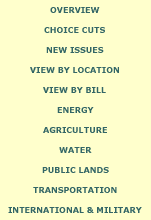
 |
 |
Issues > Public
Lands> Printer
Version
The
public land grazing program administered by the U.S. Forest Service (USFS)
and the Bureau of Land Management (BLM) is highly subsidized, benefits
only a tiny fraction of the nation's livestock operators and in 1998 cost
taxpayers roughly $100 million. Below-cost grazing fees encourage
overgrazing and, along with other problematic features of the existing
federal program, have resulted in extensive and severe environmental
damage to public lands. Green Scissors Proposal Current Status For
the third year in a row, Senator Peter Domenici (R-NM) attached a rider to
the fiscal year 2001 Interior Appropriations bill (H.R. 4578) that allows
expired grazing permits to be automatically renewed without an
environmental review. An amendment sponsored by Senator Richard Durbin
(D-IL) to strike the rider failed on a 37 to 62 vote. Program Hurts Taxpayers The current grazing fee does not cover the cost of the federal range program. The program costs at least $5.76 per animal per month (AUM), but the current fee is only $1.35 per AUM. In 1998, the grazing fee resulted in a net loss to taxpayers of $94 million. The U.S. grazing program generated only $22 million while $116 million was spent on the program - all so that less than three percent of U.S. beef could be produced by a mere two percent of U.S. ranchers - including giant corporations, millionaires and "Rolex" ranchers. The current federal fee is far below the
rates charged for grazing on private and state-owned lands in most western
states. In 1999, private rates
averaged $11.10 per AUM while typical state rates ranged from $4.40 to
$10.80. Grazing fee subsidies are not limited to USFS and BLM lands. At many U.S. military installations, grazing is free. At Fort Hood in Texas, free grazing deprives taxpayers of more than $6 million a year. The fee isn't the only subsidy. Taxpayers
also pay for fences, water tanks and other equipment that makes it
possible - and cheap - for livestock to graze federal lands.
Taxpayers also pay for predator
control measures -- $14 million worth in 1998. Program Hurts the Environment Below market fees and rancher subsidies encourage overgrazing and are often an incentive to graze environmentally sensitive lands, with resultant damage to riparian areas, soil, plants and other resources. Contacts
|
|
|